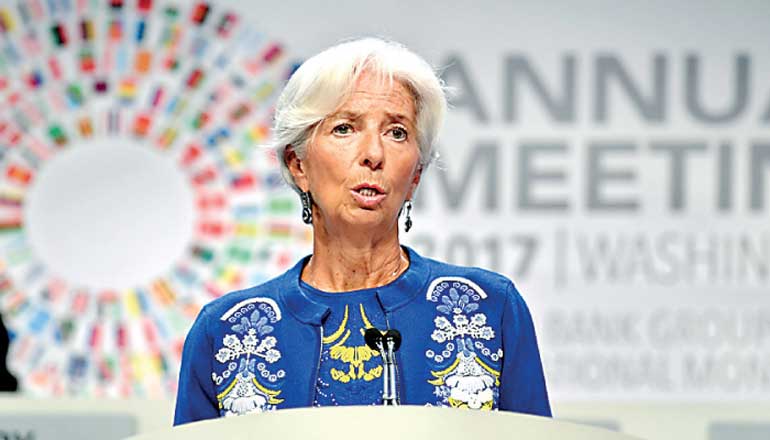Monday Apr 07, 2025
Monday Apr 07, 2025
Saturday, 14 October 2017 01:11 - - {{hitsCtrl.values.hits}}

International Monetary Fund (IMF) Managing Director Christine Lagarde makes remarks during the Plenary Session of the IMF and World Bank’s 2017 Annual Fall Meetings, in Washington, U.S., 13 October, 2017 - REUTERS
By Uditha Jayasinghe in Washington
Helped by an upswing of growth in China, Japan and Korea, Asia remains the fastest growing region in the world with 5.6% growth in 2017 but countries with large debts and weak balance sheets such as Sri Lanka remain vulnerable, the International Monetary Fund (IMF) said on Friday.
The latest 2017 Regional Economic Outlook: Asia and Pacific report called for special focus on structural reforms to avoid medium term headwinds and make use of the recovery of advanced economies that would be a positive for Asia.
“In Sri Lanka growth is expected to reach 4.7% in 2017 as buoyant construction and services offset weak and weather-affected agriculture,” the report said. The projection of 4.7% is higher than the expectations of the Central Bank, which sees growth ending between 4% and 4.5%. The Government of Sri Lanka is also working to strengthen trade relations with top performer countries in the region and is in the midst of negotiating trade deals with India, Singapore and China.
Asia continues to lead the global economy with strong growth projected at 5.6% this year and 5.5% in 2018, while overall world growth will only be at 3.6%. The strength of many economies in the region provides an opportunity to pursue key reforms that can amplify and accelerate their beneficial effects, boosting living standards for all, said the IMF in its latest regional assessment.
The IMF’s Regional Economic Outlook: October 2017 Update for Asia and Pacific cites strong consumption and investment, as well as better than anticipated external demand as driving the pickup in growth. However, with risks to growth, including rapid credit growth in China, rising protectionism, and geopolitical tensions, policymakers cannot slow the pace of reforms.
“Asia is in a favourable position as growth momentum continues to be strong. It is premature, however, to judge how long this upswing will last. The tailwinds in the region are an opportunity to pass structural reforms and address vulnerabilities,” said IMF’s Asia and Pacific Department Director Changyong Rhee.
He also warned that countries with high debt including Sri Lanka should use the opportunity to build monetary and fiscal policy to build buffers and implement stronger productivity and technology measures to combat issues such as growing inequality, low growth and demographic challenges.
Growth in China, Japan, Korea and ASEAN countries have also offset slower growth of India, which was downgraded to 6.7% on demonitisation and the recent introduction of GST, which is expected to slow growth in the short term. High levels of credit in China and persistently low inflation in Japan continue to be concerns moving forward, IMF specialists told reporters. Ongoing structural reforms in China would be crucial in deciding if the region continues to lead global growth.
“The region is thus currently in a sweet spot, but as described below, the need to place the cyclical upswing on a sustainable trajectory in some countries remain, notably in China. In addition, medium-term risks are to the downside, and over the longer term the region faces secular headwinds, including population aging and slow productivity growth,” the report said.
The IMF also warned that a sudden tightening in global financial conditions could trigger disruptive capital outflows that would affect particularly those emerging and developing Asian economies and weaken their growth prospects.
“A sharp adjustment in China due to unsustainable policies, further increases in debt, and mounting financial imbalances also present risks to the region’s outlook,” it said.
Furthermore, as Asian economies are especially vulnerable to protectionism because of their trade openness and integration to global value chains, a global shift toward inward-looking policies could suppress Asia’s exports and reduce foreign direct investment in the region. Escalating geopolitical risks could also negatively impact the region’s medium-term growth prospects, the report added.
Discover Kapruka, the leading online shopping platform in Sri Lanka, where you can conveniently send Gifts and Flowers to your loved ones for any event including Valentine ’s Day. Explore a wide range of popular Shopping Categories on Kapruka, including Toys, Groceries, Electronics, Birthday Cakes, Fruits, Chocolates, Flower Bouquets, Clothing, Watches, Lingerie, Gift Sets and Jewellery. Also if you’re interested in selling with Kapruka, Partner Central by Kapruka is the best solution to start with. Moreover, through Kapruka Global Shop, you can also enjoy the convenience of purchasing products from renowned platforms like Amazon and eBay and have them delivered to Sri Lanka.
Discover Kapruka, the leading online shopping platform in Sri Lanka, where you can conveniently send Gifts and Flowers to your loved ones for any event including Valentine ’s Day. Explore a wide range of popular Shopping Categories on Kapruka, including Toys, Groceries, Electronics, Birthday Cakes, Fruits, Chocolates, Flower Bouquets, Clothing, Watches, Lingerie, Gift Sets and Jewellery. Also if you’re interested in selling with Kapruka, Partner Central by Kapruka is the best solution to start with. Moreover, through Kapruka Global Shop, you can also enjoy the convenience of purchasing products from renowned platforms like Amazon and eBay and have them delivered to Sri Lanka.